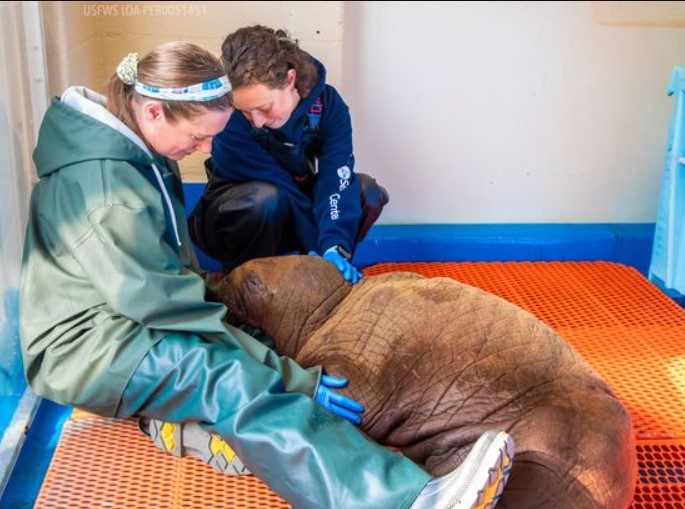A baby walrus that was found alone and stranded on the North Slope of Alaska is receiving constant care and affection from the staff of the Alaska SeaLife Center. The one-month-old calf, which weighs about 140 pounds, is being nursed back to health with round-the-clock cuddles and formula feedings.

A rare and exceptional rescue
The Pacific walrus calf was discovered by oil field workers on August 1, about four miles inland from the Beaufort Sea. This is a highly unusual location for a walrus, as they typically live in the ocean or near the western coastline. The workers contacted the U.S. Fish and Wildlife Service, which authorized the rescue of the calf.
The calf was flown to Seward, where the Alaska SeaLife Center is located. The center is the only marine mammal rehabilitation facility in the state, and has only admitted 10 walruses in its 25-year history. The last walrus patient was in 2019.
The center’s wildlife response curator, Jane Belovarac, said the rescue was a rare and exceptional event. “It isn’t often that we’re able to admit a walrus calf, but every time we do, we learn more about the species and how to care for them,” she said.
A mother’s warmth
Walrus calves are highly dependent on their mothers for the first two years of their life. They nurse frequently, stay close to their mothers, and learn how to socialize and survive in their environment. Without maternal care, a calf has little chance of survival.
The center’s staff is trying to provide the calf with the best possible substitute for a mother’s warmth and attention. They are giving him 24/7 cuddles, which help him stay calm and comfortable. They are also feeding him a special formula every three hours, which mimics the high-fat content of walrus milk.
The staff said the calf is very responsive to human touch and vocalizations. He often rests his head on their laps or leans against them. He also makes various sounds, such as grunts, whistles, and clicks.
A hopeful recovery
The calf arrived at the center in a critical condition. He was dehydrated, malnourished, and had a cloudy eye that could indicate an infection. He also had some abrasions on his skin and flippers.
The staff is monitoring his health closely and providing him with medical treatment. They are also collecting blood samples and fecal samples to test for diseases and parasites. They are hopeful that he will recover and grow stronger with time.
The calf’s future is uncertain, as he cannot be released back into the wild. He will need to be placed in a permanent facility that can provide him with adequate care and companionship. The center is working with the U.S. Fish and Wildlife Service to find a suitable home for him.
The center is also asking the public to help name the calf. They have launched an online poll with four options: Aaquk (Ah-ahk), meaning “ice” in Inupiaq; Kulu (Koo-loo), meaning “baby” in Inuit; Tuktu (Took-too), meaning “caribou” in Inuit; and Uki (Oo-kee), meaning “survivor” in Inuit. The poll will close on August 15.







